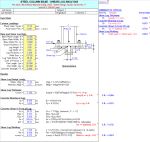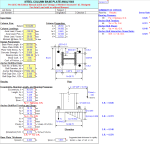BASEPLT9.xls
Description
"BASEPLT9" is a spreadsheet program written in MS-Excel for the purpose of analysis of steel column base plates. Specifically, wide flange column base plates may be subjected to axial loads (compression or tension), with or without major-axis column bending, plus major-axis shear. Base plate bearing pressure is checked as well as bolt tension, if applicable. If shear is present, bolt shear as well as interaction of bolt tension and shear, if applicable, are calculated. Finally, the required base plate thickness is calculated. There is a separate worksheet for base plate shear lug design, when shear load is high and cannot be effectively handled by bolts.
This program is a workbook consisting of four (4) worksheets, described as follows:
Program Assumptions and Limitations:
1. This program follows the procedures and guidelines of the AISC 9th Edition Allowable Stress (ASD) Manual (2nd Revision, 1995) for wide flange column base plates subjected to axial compressive load only.
2. This program uses a "cubic equation" method of solution for column base plates subjected to axial compression or tension load with major axis column bending as presented in the reference:
"Design of Welded Structures" - by Omer W. Blodgett (James F. Lincoln Arc Welding Foundation)
3. For interaction of anchor bolt tension and shear, this program follows the article:
"Design Aid: Anchor Bolt Interaction of Shear and Tension Loads", by Mario N. Scacco
AISC Engineering Journal, 4th Quarter - 1992.
4. User has option to take out some of the total shear though friction between column base and grout based on column dead load and coefficient of friction, thus reducing amount of shear to be taken by anchor bolts.
5. This program uses the database of member dimensions and section properties from the "AISC Shapes
Database", Version 3.0 (2001) as well as the AISC 9th Edition (ASD) Manual (1989).
6. This program assumes that the base plate is sufficiently rigid to assume linear distribution of load to the base plate and/or anchor bolts. (Note: adequate base plate rigidity is most likely assured if the distance from the face of the column to the edge of the base plate is <= 4*tp. See "General Anchorage to Concrete",
TVA Civil Design Standard DS-C1.7.1 (Rev. 1984), page 25.)
7. Additional assumptions used in this program are as follows:
a. The column is centered on the base plate in both directions.
b. Axial column load, 'P', can be = 0 for the case with moment.
c. The minimum area of concrete support is: A2(min) = N*B.
d. For a base plate supported on a slab or mat, use A2 = 4*(N*B).
e. Two (2) total rows of anchor bolts are allowed, one row outside of each column flange.
f. There must be an equal number of anchor bolts in each of the two (2) rows.
8. For cases with anchor bolt tension and base plate bearing, this program calculates the bending moment in the base plate at two locations. One, at the column flange in compression using the bearing pressure distribution, and the other at the column flange in tension using the tension in one bolt distributed over an assumed width effective plate width based on edge distances and bolt spacing. At both locations, the moment and resulting base plate thickness are calculated using a "cantilever" length equal to the calculated "m" distance from the AISC code. Then, the larger of the two calculated thickness values is used for the required base plate thickness. (Note: this program assumes that the anchor bolts are not located in plan significantly beyond the ends of the column flange, so that corner-type plate bending does not control.)
9. The "Shear Lug" worksheet follows the AISC "Steel Design Guide Series #7 - Industrial Buildings - Roofs to Column Anchorage" (page 33 and pages 38-40).
10. The "Base Plate (Table)" worksheet enables the user to analyze/design virtually any number of individual column bases or column load combinations. Refer to that worksheet for list of specific assumptions used.
11. This program contains numerous “comment boxes” which contain a wide variety of information including explanations of input or output items, equations used, data tables, etc. (Note: presence of a “comment box” is denoted by a “red triangle” in the upper right-hand corner of a cell. Merely move the mouse pointer to the desired cell to view the contents of that particular "comment box".)
This program is a workbook consisting of four (4) worksheets, described as follows:
| Worksheet Name | Description | ||||||||
| Doc | This documentation sheet | ||||||||
| Base Plate | Steel column base plate analysis | ||||||||
| Shear Lug | Steel column base - shear lug analysis | ||||||||
| Base Plate (Table) | Multiple steel column base plate analysis (table format) | ||||||||
Program Assumptions and Limitations:
1. This program follows the procedures and guidelines of the AISC 9th Edition Allowable Stress (ASD) Manual (2nd Revision, 1995) for wide flange column base plates subjected to axial compressive load only.
2. This program uses a "cubic equation" method of solution for column base plates subjected to axial compression or tension load with major axis column bending as presented in the reference:
"Design of Welded Structures" - by Omer W. Blodgett (James F. Lincoln Arc Welding Foundation)
3. For interaction of anchor bolt tension and shear, this program follows the article:
"Design Aid: Anchor Bolt Interaction of Shear and Tension Loads", by Mario N. Scacco
AISC Engineering Journal, 4th Quarter - 1992.
4. User has option to take out some of the total shear though friction between column base and grout based on column dead load and coefficient of friction, thus reducing amount of shear to be taken by anchor bolts.
5. This program uses the database of member dimensions and section properties from the "AISC Shapes
Database", Version 3.0 (2001) as well as the AISC 9th Edition (ASD) Manual (1989).
6. This program assumes that the base plate is sufficiently rigid to assume linear distribution of load to the base plate and/or anchor bolts. (Note: adequate base plate rigidity is most likely assured if the distance from the face of the column to the edge of the base plate is <= 4*tp. See "General Anchorage to Concrete",
TVA Civil Design Standard DS-C1.7.1 (Rev. 1984), page 25.)
7. Additional assumptions used in this program are as follows:
a. The column is centered on the base plate in both directions.
b. Axial column load, 'P', can be = 0 for the case with moment.
c. The minimum area of concrete support is: A2(min) = N*B.
d. For a base plate supported on a slab or mat, use A2 = 4*(N*B).
e. Two (2) total rows of anchor bolts are allowed, one row outside of each column flange.
f. There must be an equal number of anchor bolts in each of the two (2) rows.
8. For cases with anchor bolt tension and base plate bearing, this program calculates the bending moment in the base plate at two locations. One, at the column flange in compression using the bearing pressure distribution, and the other at the column flange in tension using the tension in one bolt distributed over an assumed width effective plate width based on edge distances and bolt spacing. At both locations, the moment and resulting base plate thickness are calculated using a "cantilever" length equal to the calculated "m" distance from the AISC code. Then, the larger of the two calculated thickness values is used for the required base plate thickness. (Note: this program assumes that the anchor bolts are not located in plan significantly beyond the ends of the column flange, so that corner-type plate bending does not control.)
9. The "Shear Lug" worksheet follows the AISC "Steel Design Guide Series #7 - Industrial Buildings - Roofs to Column Anchorage" (page 33 and pages 38-40).
10. The "Base Plate (Table)" worksheet enables the user to analyze/design virtually any number of individual column bases or column load combinations. Refer to that worksheet for list of specific assumptions used.
11. This program contains numerous “comment boxes” which contain a wide variety of information including explanations of input or output items, equations used, data tables, etc. (Note: presence of a “comment box” is denoted by a “red triangle” in the upper right-hand corner of a cell. Merely move the mouse pointer to the desired cell to view the contents of that particular "comment box".)
Calculation ReferenceAISC | Find on Amazon.com | Find on Amazon.co.uk | Find on Amazon.fr | Find on Amazon.de | Find on Amazon.ca |
Calculation Preview
Uploaded
14 Apr 2009
Submitted By:
Last Modified
14 Apr 2009
File Size:
498.00 Kb
Downloads:
1945
File Version:
3.7
Full download access to any calculation is available to users with a paid or awarded subscription (XLC Pro).
Subscriptions are free to contributors to the site, alternatively they can be purchased.
Click here for information on subscriptions.



This has now been done, and the workbook is now version 3.7.
By the way for us ASD 9th Edition "die-hards", the "BeamCol(Built-Up)" worksheet is a useful tool for doing AISC Code checks using metric shapes, in that all you need to do is enter a formula in the input cells for each of the dimensions (d, tw, bf, and tf) in millimetres divided by 25.4, and the worksheet will automatically calculate all of the properties for you. Keep in mind that the "fillets" of the member are not considered, so the calculated properties will be very close approximations.
I'll first have to learn the AISC 13th Edition....at least I do have the Manual. :lol:
However, I need to take care of what's on my plate first. That includes updates for ACI 318-05 Code concrete, ASCE 7-05 Code wind analysis, and IBC 2006 Code seismic analysis.
Then this "old dog" will try to learn some new tricks....as in the AISC 13th Edition design.
Alex